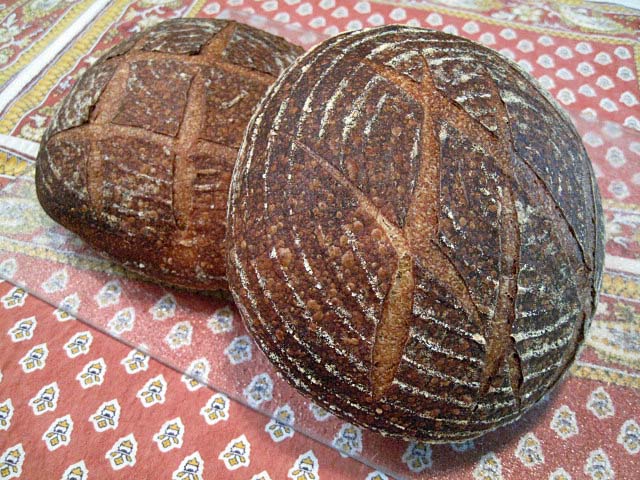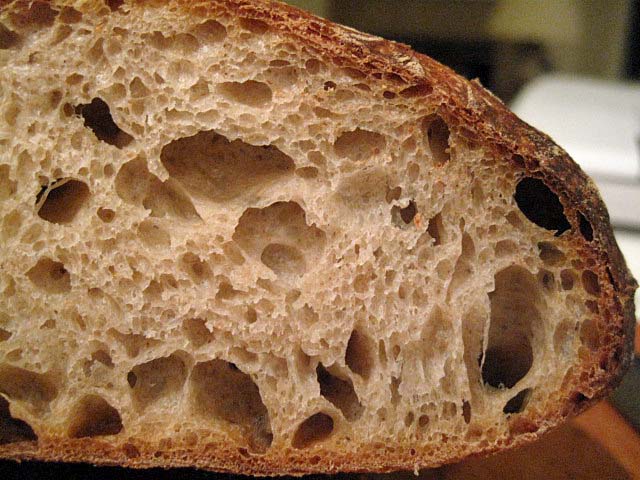
Hamelman's "Pain au Levain with Whole Wheat Flour"

Many TFL baker's have blogged on this bread, and for good reason. It is delicious. I haven't made it since last October. Today, I made three 568 g boules. I started with a liquid starter which I converted to a firm starter and fed twice before mixing the final dough. The formed loaves were cold retarded for about 16 hours then proofed at 85 dF for 2 1/2 hours before baking.



I have been making Hamelman's Pain au Levain frequently for many months and enjoying it a lot. This week, I just felt like something with more of a whole grain flavor and recalled this bread. Looking back at my earlier blog, today's bake was significantly better when tasted after a couple hours' cooling. There was none of what I had described as a "grassy" flavor. This bread was simply delicious with a sweet, nutty, crunchy crust and a chewy crumb with a nice wheaty, mildly sour flavor.
I'm going to stick with this one ... except I do want to try the mixed levain version again.
David


Comments
Got to love your scoring , David. You always nail the perfect time for loading a proofed dough into the oven, so that it blooms just right! Tells alot about the skills and experince of the baker, let alone the appearance of the crust with all of those beautiful blisters.
The crumb is perfect! Everything is perfect here.
David
Magnificent, David!
I have not forgotten that your bake of this bread in 2009 resulted in Jeffrey Hamelman's first visit to TFL and some very nice compliments for you. (See Hans' loaf)
David
bread. I think retirement has helped your baking if that is possible ! Gorgeous color, thick crust, crumb and texture all beautiful. I really like the irregular holes.
David
What a lovely crumb. I love the 'birdeye' crust. When I return home from vacation in cool Aspen....awww retirement and loving it, you are an inspiration to bake even in the warm weather....no sweat :) It's so true, you'll wonder how you ever found the time to work : )
Sylvia
David
David,
What is the difference between using a regular starter and a firm starter? How do you convert regular starter to firm starter? How does a firm starter benifit the bread diferently from regular starter?
Thanks,
Francine
A liquid (generally 100% hydration) and a firm (generally 50% hydration) starter are both "regular." I say "generally," because you can find recipes with different starter hydration levels than the ones given.
For a good discussion of the issues raised by your other questions, see this topic: Sourdough Bread from SFBI Artisan II and read the whole thing.
Happy baking!
David
Excellent bake as always David.
You crust and crumb look as good as it gets.
Regards,
Ian
David
The only improvement I can think of would be to have a slice of it in my hand.
Paul
I've just about given up waiting for some one to develop fax-a-slice technology. Same goes for the scratch and sniff monitor. It's really a shame.
David
Now that you're retired you should have plenty of time to work on a "Bread Transporter"!
When you get that down the world will be a better place! Just give me a footnote when you get the patent :)
Ian
100% Whole Wheat bread David? No worries. I just read on hasjokin's blog that you linked to that it was 25% whole wheat.
Great looking bread, David.
-Floyd
David
...and you've done it up nicely!
Glenn
This could become one of my favorites too.
David
Hi David,
Great looking loaves. Have you described your cold fermentation somewhere? Is it as simple as a fridge, or something a bit warmer. I've found methods that work for me in cooler weather but summer leaves me at a loss for cold fermentation.
-Ed
Hi, Ed.
My only option is the fridge which is 40 dF. I believe Hamelman gives retardation times for both 50 and 40 dF. My understanding is that, if you are retarding primarily for flavor development, 50 dF is ideal. At 40 dF, metabolic processes really slow down when the dough cools to that temperature.
Some buy wine coolers to use for cold retardation at 50 dF for the home setting. Commercial bakeries have products expressly designed for this purpose.
David
your beautiful loaves really motivate me to look into "Bread" again.
With your substantial production - what do you do with all your bread?
Karin
I gift a few loaves to neighbors and friends, but most get eaten by my wife and me. I eat some bread at most meals. We love French toast and garlic bread and make some dishes with bread crumbs. Very little gets wasted. Most gets waisted, I'm afraid.
David
Yes, David, that is the burden we have to bear....
Karin
Lovely bread, David; great formula and mastering of all the process
Wishing you a very happy retirement; will you be baking even more bread now?
All good wishes
Andy
I appreciate your kind words.
I don't expect to be making more bread, unless I find a new outlet. I hope to have the time to tackle some more complex breads I've not made successfully before - like some of your rye's. I may work in some classes. For example, I've wanted to take a class from Jeff Hamelman. I've thought some about teaching myself, but I need to explore the level of interest among possible students.
David
hi david
where can i finf the receipe for this bread please?
The formula is in "Bread," by Jeffrey Hamelman.
Have you tried searching TFL? Maybe some one has posted the formula.
David
Hi David,
I should look at TFL before baking, not after, but I seem to always do it after I am done baking...
I proofed my formed loaves for 2 1/2 hours and then retarded them. I baked immediately after taking the loaves out of the fridge. In retrospect, I realize that I proofed the loaves for far too long before retarding and should have proofed for only about an hour since I did not get as much rise as expected.
You say you proofed the loaves for 2 1/2 hours at 85 dF after removing from the fridge. Did you do a proof before retarding? Is the after-retarding proof better? How did you decide on this method?
Thanks, Karyn
Sorry, I misstated my proofing time, mixing it up in my mind with my bulk ferment time of 2 1/2 hours.
I bulk fermented for 2 1/2 hours, but did not proof the loaves at all, immediately retarding after forming the loaves. I am wondering if I should have proofed for a minimum time of about an hour prior to retarding or proofing after retarding as you did. I did not get much of a rise wonder what you think and how you decided to proof afterwards.
Thanks, Karyn